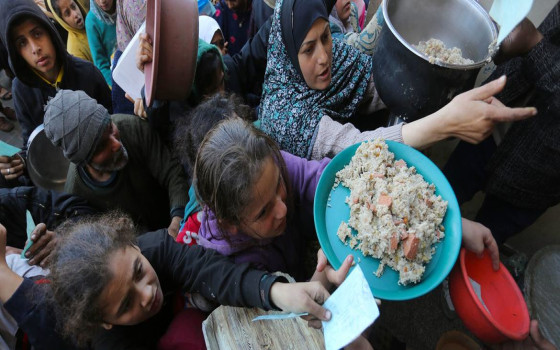
Global report: Dangerous levels of acute hunger, especially in Gaza and Sudan. More than 280 million people have been affected by worsening food insecurity for the fifth year in a row.

- Europe and Arabs
- Thursday , 25 April 2024 12:31 PM GMT
Capitals: Europe and the Arabs
UN agencies have warned that dangerous levels of acute hunger affected a staggering number of people – 281.6 million people – last year, marking the fifth consecutive year that food insecurity has worsened, adding to growing fears of famine and “widespread death across the world.” Wide scope" in Gaza, Sudan and other areas.
According to the Global Report on Food Crises released on Wednesday, more than one in five people in 59 countries faced acute food insecurity in 2023, compared to only one in 10 people in 48 countries in 2016.
“When we talk about acute food insecurity, we are talking about extreme hunger that poses a direct threat to people’s livelihoods and lives,” said Dominique Bourgeon, Director of the UN Food and Agriculture Organization (FAO) Liaison Office in Geneva. “This is a hunger that threatens to slide into famine and cause death on a daily basis.” wide range".
The joint report by the Food and Agriculture Organization (FAO), the World Food Program and the United Nations Children's Fund (UNICEF) found that although the overall proportion of people suffering from food insecurity last year was 1.2 percent lower than in 2022, the problem has worsened significantly. Significant since the Covid-19 crisis.
The report indicated that about one in six people in 55 countries were facing alarming levels of food insecurity when the Corona virus appeared in late 2019, and the rate rose to one in five just one year later.
"People are dying of hunger in Gaza"
Gian Carlo Siri, Director of the World Food Program Office in Geneva, said that food crises have escalated alarmingly in 2023, noting particular concerns about Gaza and Sudan. He said that in Gaza, "people are clearly dying of hunger."
After nearly seven months of Israeli bombing, “people cannot meet even basic nutritional needs,” according to Siri. “They have exhausted all coping strategies, such as eating animal feed, begging, and selling their possessions to buy food. Most of the time they "They are destitute, and it is clear that some of them are dying of hunger."
He told reporters in Geneva that the only way to stop the famine was to ensure daily food supplies "in a very short time."
He added: “We talked about the need to rebuild livelihoods, address root causes, etc. But right now, we really need to significantly increase our food supply. This means providing massive and consistent food aid in conditions that allow humanitarian workers and supplies to move freely and for those affected by Reach help safely.
The new warning on Gaza is in line with repeated harsh assessments from experts in the field of food insecurity who have warned that famine could occur “at any time” between now and May 2024 in the northern governorates.
In this context, Siri said: “We are getting closer every day to famine. Malnutrition is widespread among children. We estimate that 30 percent of children under the age of two now suffer from severe malnutrition or wasting, and that 70 percent of the population in the north faces "There is reasonable evidence that all three famine thresholds - food insecurity, malnutrition and mortality - will be crossed in the next six weeks."
Sudan is in danger
Regarding Sudan, the UN report indicated that 20.3 million people - or 42 percent of the population - struggled to find enough food last year, after the conflict broke out in April 2023.
This represents the largest number of people in the world facing “emergency” levels of acute food insecurity, or stage 4 in the IPC, with stage 5 indicating the highest level of risk.
The report stressed the need to allow humanitarian aid to reach immediately into and through Sudan to avoid further deterioration of the situation, while there are only a few weeks left before the start of the planting season.
FAO official Dominique Bergion said: “What raises our grave concern is that the bulk of these people depend on agriculture for their livelihood. Gezira State, for example, is vital for food production. About 50 percent of Sudan’s wheat production comes from the state.”
He stressed the need to provide people with agricultural inputs on time so that they can plant their fields wherever possible, and added: “If these people fail to plant their fields, it means that we have to be prepared for huge food aid requirements until the next harvest season in the year.” "Next."
The report also indicated that people in South Sudan, Burkina Faso, Somalia and Mali are likely to experience the worst levels of food insecurity – i.e. food insecurity stage 5 – in 2023.
The report's authors emphasized that data was not available for some countries facing ongoing food concerns, including Ethiopia, while also noting that in Haiti there were 19,200 people who had been classified as Stage 5 from September 2022 to February 2023 "and no longer face... These conditions will remain for the rest of 2023.”
Last year, some 36 million people in 39 countries faced IPC Phase 4 – emergency levels, four per cent more than in 2022. More than a third of them were in Sudan and Afghanistan.
The report said: “Households in this dire situation face significant food gaps, which are either reflected in high rates of acute malnutrition and excess mortality and are mitigated using emergency coping strategies.” About 165.5 million people in 41 countries also faced crisis levels - that is, the stage The third stage of food insecurity - and about 292 million people in 40 countries are classified in the fourth stage.












No Comments Found